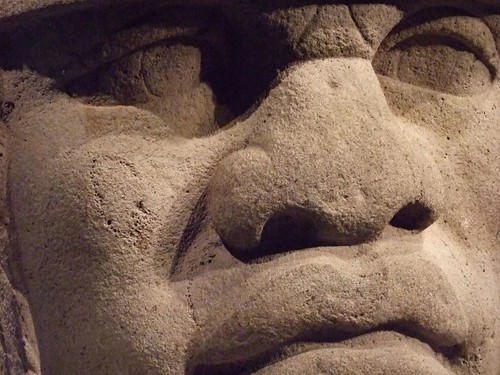The tomb held a man aged around 50, who was buried with jade collars, pyrite and obsidian artifacts and ceramic vessels. Archaeologist Emiliano Gallaga said the tomb dates to between 500 and 700 B.C. Based on the layers in which it was found and the tomb's unusual wooden construction, "we think this is one of the earliest discoveries of the use of a pyramid as a tomb, not only as a religious site or temple," Gallaga said.Like many people of my generation, I was taught that the earliest culture to construct pyramids was the Maya. But this find clearly illustrates native peoples that preceded the Mayans used monumental architecture for ritualistic purposes as well.
The body of a 1-year-old child was laid carefully over the man's body inside the tomb, while that of a 20-year-old male was tossed into the chamber with less care, perhaps sacrificed at the time of the burial.
The older man was buried with jade and amber collars and bracelets and pearl ornaments. His face was covered with what may have been a funeral mask with obsidian eyes. Nearby, the tomb of a woman, also about 50, contained similar ornaments.
The ornaments — some imported from as far away as Guatemala and central Mexico — and some of the 15 ceramic vessels found in the tomb show influences from the Olmec culture, long considered the "mother culture" of the region. - Fox News
I found this interesting article that gives further background on the Zoque people. It also points out that the earliest archaeological remains of "public architecture" was not in Central America at all but at Watsons Brake in northern Louisiana!
The appearance of ceramics in Mexico coincided with either the arrival of a new people or sudden fluorescence of an existing people around 1600 BC in the tepid lowlands of what is now the states of Vera Cruz and Tabasco, adjacent to the Gulf of Mexico. They called themselves the Zoque. According to their own legends, they crossed the Gulf of Mexico in three great flotillas of giant canoes, to arrive in their new homeland. Three thousand years later the Aztecs called the inhabitants of this region, the Olmecs, which means “rubber people.” It is not known if the builders of the ancient ceremonial complexes in Vera Cruz and Tabasco are one and the same as the people occupying the region in 1500 AD. However, the process of making rubber by mixing the saps of an indigenous rubber tree and an indigenous vine seems to coincide with the arrival of the Zoque.
Around 1400 BC the first large ceremonial complex appeared in the Zoque lands. Known today by the Spanish name of San Lorenzo, it featured earthen mounds and geometric forms grouped around plazas. The theocratic elite lived near the ceremonial complex, but the commoners were dispersed in hamlets and farmsteads across a large expanse of territory. It is quite likely that the farmers only lived in the same location as long as their soils remained fertile. There was very little exposed stone in the region so all of the architecture was of wood, clay and earth. The palace of the king or high priest has stone columns to support its roof, plus stone cisterns and steps. Any stone used in art, was imported from 80-150 miles away by river transportation.San Lorenzo was abandoned around 900 AD. - The Mesoamerican Connection by Richard Thornton, Examiner.com
Mr. Thornton goes on to describe Zoque stone sculptures depicting men with beards led some people to jump to the erroneous conclusion that the Americas must have been initially settled by early Europeans based on this evidence.
[Colossal head from Monument 4 Veracruz Mexico Omec 1200-900 BCE Basalt. Photographed by Mary Harrsch at the DeYoung Museum of Fine Art, San Francisco, CA]
The fact is that several indigenous peoples of the Western Hemisphere wore beards and even mustaches. These include the tribes of the Northwest Pacific Coast, the Aztecs, and the Creeks of the Southeast. The chroniclers of the de Soto Expedition (1539-1543) commented on an elderly Okonee (branch of Creeks) leader who had a beard down to his belly button. - The Mesoamerican Connection by Richard Thornton, Examiner.comI have been privileged to see one of the more iconic Olmec stone sculptures of men wearing leather helmets at the DeYoung Museum of Fine Art in San Francisco. The DeYoung has an excellent collection of early American Art and I would encourage you to put it on your agenda the next time you travel to the Bay Area.
Here's a slideshow of some of the wonderful art I photographed there several years ago:




No comments:
Post a Comment